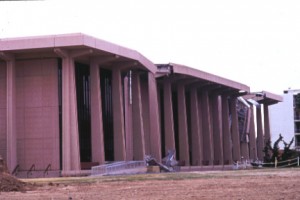Symbol of Resilience: The Life and Times of the Oviatt’s American Flag
Enduring the 110-degree heat, the smoke of wildfires and the harsh winds of freezing, rainy days, she stays flying. At the crown of the Delmar T. Oviatt Library, CSUN’s very own American flag stands, even when everyone else has gone home.
Representing our nation’s independence, the American flag was adopted on June 14, 1777 — now celebrated annually as Flag Day — when the Second Continental Congress passed the Flag Resolution. The resolution set the flag with 13 red and white stripes and 13 white stars on a blue background, representing the fledgling United States’ 13 colonies, long before the country grew to 50 states with 50 corresponding stars on its flag.
More than two centuries later, CSUN raised the Stars and Stripes at the heart of campus for another reason.

Exterior damage to the Delmar T. Oviatt Library after the 1994 earthquake. Photo courtesy of the Oviatt’s Earthquake Gallery.
The date to remember is Jan. 17, 1994 — the day a magnitude 6.7 earthquake struck the San Fernando Valley, killing 72 people. It injured 9,000 people, destroyed 22,000 homes across the region and caused catastrophic damage throughout the CSUN campus. Among the victims were two CSUN students who perished in the collapse of the Northridge Meadows apartments.
It was a seminal moment for the university, which reopened for spring semester classes just two weeks after the disaster struck. Numerous buildings and parking structures on CSUN’s campus had sustained severe damage, including the iconic Oviatt Library, whose east and west wings were badly damaged. However, the CSUN community didn’t stay down. In the wake of the destruction, students, faculty and staff came together to pick up the pieces and rebuild the university.
By 1995, the campus began to see a brand-new landscape with the construction of new buildings.
The core of the partially restored Oviatt Library reopened in fall 1994. In 2000, the university rededicated and reopened the rebuilt wings. At that time, the Oviatt gained two additions — its signature grand staircase and a prominent American flag.
Measuring an impressive 12-by-18 feet, the flag commemorates CSUN’s resilience in the quake’s aftermath.
The flag flies 24/7 — and is illuminated at night. CSUN employees lower it to half-staff only for memorial days or occasions of national mourning, and bring it down only when it needs to be replaced.
The library staff is not in charge of raising, lowering or replacing the flag. That duty falls to the Physical Plant Management (PPM) staff.
The majority of CSUN students, faculty and staff get a regular glimpse of the flag atop the Oviatt Library, but many are unaware of its campus history and the effort involved to keep it flying.
The U.S. Flag Code provides standards for raising and lowering the flag at the beginning and end of each day. These standards include saluting the flag as it is hoisted and lowered.
The Oviatt flag is so big that it takes a “minimum two, and often three” people to handle it properly when raised and lowered, said Jim Logsdon, director of grounds, custodial and events for PPM.
“Our role in Physical Plant is less pomp and circumstance than you might think,” said Anthony Parker, PPM’s assistant director of engineering services. “We treat the flag with respect when we raise or lower it. We never let it touch the ground, and if it is worn, we replace it.”
With two or more pairs of hands on the job, one can untie the halyard to release the flag, and another can receive and, as required, fold it. “You want to be able to maneuver it,” Logsdon said.
Occasionally, the flag is lowered to half-staff, symbolic of national or institutional mourning as well as commemoration of the men and women who made the ultimate sacrifice for the country. The flag is customarily flown at half-staff in accordance with the U.S. Flag Code and federal public law on Peace Officers Memorial Day on May 15, Memorial Day on the last Monday in May, Patriot Day on Sept. 11, National Fallen Firefighters Memorial Day on the first Sunday in October, and on Pearl Harbor Remembrance Day on Dec. 7.
To maintain the flag, which flies under a punishing summer sun, brutal winds and rainstorms throughout the year, a standard rotation schedule dictates it be changed out with a new one every quarter: before the beginning of the fall semester in August, in November, in February and finally in May, before CSUN’s annual commencement ceremonies. Replacement may happen at other times during the year, depending on wear and tear.
Jason Billick, the Oviatt’s logistical services supervisor, is in charge of purchasing the replacement flags, at about $200 each, through the library’s supplies budget.
The U.S. Flag Code states that once a flag is no longer suited for display — either weathered or tarnished — it must be destroyed in “a dignified way.” But when PPM has replaced the Oviatt’s flag, they don’t carry this out themselves. Instead, they hand over old flags to the Veterans Administration to destroy or repurpose them.
First raised to demonstrate resilience, the library’s American flag holds timeless importance at the heart of campus.
“The Oviatt is the centerpiece of the university,” Logsdon said. “The flag just stamps that foundation even more.”



 experience
experience